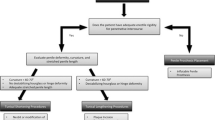Abstract
Purpose of Review
Tunical plaque incisions are common techniques utilized during grafting procedures for Peyronie’s disease. The aim of this review was to examine the different tunical incisional and excisional techniques, as well as outcomes and complications of recent graft procedures utilizing these strategies.
Recent Findings
Studies on tunical incision, partial excision, and grafting techniques vary with regards to their surgical outcomes, post-operative erectile dysfunction rates, and other complications. Overall, significant penile straightening has been reported in recent studies of incision and grafting for Peyronie’s disease.
Summary
Prospective trials comparing the different tunical incisional techniques are needed to better plan surgical interventions for Peyronie’s disease.

Similar content being viewed by others
References
Papers of particular interest, published recently, have been highlighted as: • Of importance •• Of major importance
Dibenedetti DB, Nguyen D, Zografos L, Ziemiecki R, Zhou X. A population-based study of Peyronie’s disease: prevalence and treatment patterns in the United States. Adv Urol. 2011;2011:282503.
Stuntz M, Perlaky A, des Vignes F, Kyriakides T, Glass D. The prevalence of Peyronie’s disease in the United States: a population-based study. PLoS One. 2016;11(2):e0150157.
Chung E, Ralph D, Kagioglu A, Garaffa G, Shamsodini A, Bivalacqua T, et al. Evidence-based management guidelines on Peyronie’s disease. J Sex Med. 2016;13(6):905–23.
Nehra A, Alterowitz R, Culkin DJ, Faraday MM, Hakim LS, Heidelbaugh JJ, et al. Peyronie’s Disease: AUA Guideline. J Urol. 2015;194(3):745–53.
Hatzichristodoulou G, Meisner C, Gschwend JE, Stenzl A, Lahme S. Extracorporeal shock wave therapy in Peyronie’s disease: results of a placebo-controlled, prospective, randomized, single-blind study. J Sex Med. 2013;10(11):2815–21.
Bilgutay AN, Pastuszak AW. Peyronie’s disease: a review of etiology, diagnosis, and management. Curr Sex Health Rep. 2015;7(2):117–31.
Yang KK, Bennett N. The history of collagenase Clostridium histolyticum. Sex Med Rev. 2015;3(4):289–97.
Larsen SM, Levine LA. Review of non-surgical treatment options for Peyronie’s disease. Int J Impot Res. 2012;24(1):1–10.
Ralph D, Gonzalez-Cadavid N, Mirone V, Perovic S, Sohn M, Usta M, et al. The management of Peyronie’s disease: evidence-based 2010 guidelines. J Sex Med. 2010;7(7):2359–74.
Hatzimouratidis K, Eardley I, Giuliano F, Hatzichristou D, Moncada I, Salonia A, et al. EAU guidelines on penile curvature. Eur Urol. 2012;62(3):543–52.
•• Hatzichristodoulou G, Osmonov D, Kubler H, Hellstrom WJ, Yafi FA. Contemporary Review of Grafting Techniques for the Surgical Treatment of Peyronie’s Disease. Sex Med Rev. 2017. This study reviews current methods of surgical management for PD.
• Lipshultz LI, Goldstein I, Seftel AD, Kaufman GJ, Smith TM, Tursi JP, et al. Clinical efficacy of collagenase clostridium histolyticum in the treatment of Peyronie’s disease by subgroup: results from two large, double-blind, randomized, placebo-controlled, phase III studies. BJU Int. 2015;116(4):650–6. This prospective study evaluates the efficacy of collagenase clostridium histolyticum in the treatment of PD.
• Gelbard M, Goldstein I, Hellstrom WJ, CG MM, Smith T, Tursi J, et al. Clinical efficacy, safety and tolerability of collagenase clostridium histolyticum for the treatment of peyronie disease in 2 large double-blind, randomized, placebo controlled phase 3 studies. J Urol. 2013;190(1):199–207. This prospective study evaluates the efficacy of collagenase clostridium histolyticum in the treatment of PD.
• Levine LA, Dimitriou RJ. A surgical algorithm for penile prosthesis placement in men with erectile failure and Peyronie’s disease. Int J Impot Res. 2000;12(u):147–51. This study reviews the algorithm for prosthesis placement in men with PD and ED.
El-Sakka AI, Rashwan HM, Lue TF. Venous patch graft for Peyronie’s disease. Part II: outcome analysis. J Urol. 1998;160(6 Pt 1):2050–3.
• Egydio PH, Lucon AM, Arap S. A single relaxing incision to correct different types of penile curvature: surgical technique based on geometrical principles. BJU Int. 2004;94(7):1147–57. This study evaluates a novel technique using geometry for tunical incisions.
Brant WO, Bella AJ, Garcia MM, Tantiwongse K, Lue TF. Surgical atlas. Correction of Peyronie’s disease: plaque incision and grafting. BJU Int. 2006;97(6):1353–60.
Flores S, Choi J, Alex B, Mulhall JP. Erectile dysfunction after plaque incision and grafting: short-term assessment of incidence and predictors. J Sex Med. 2011;8(7):2031–7.
• Yafi FA, Pinsky MR, Sangkum P, Hellstrom WJ, et al. Andrology. 2015;3(4):650–60. This study reviews different therapies available for PD.
Cantoro U, Polito M, Catanzariti F, Montesi L, Lacetera V, Muzzonigro G. Penile plication for Peyronie’s disease: our results with mean follow-up of 103 months on 89 patients. Int J Impot Res. 2014;26(4):156–9.
Novick AC, Streem SB, Pontes JE, Stewart BH. Stewart’s operative urology. 2nd ed. Baltimore: Williams & Wilkins; 1989.
McVary KT. Contemporary treatment of erectile dysfunction : a clinical guide. New York: Humana; 2011. xii, 287 p. p.
Segal RL, Burnett AL. Surgical Management for Peyronie’s disease. World J Mens Health. 2013;31(1):1–11.
• Kozacioglu Z, Degirmenci T, Gunlusoy B, Kara C, Arslan M, Ceylan Y, et al. Effect of tunical defect size after Peyronie’s plaque excision on postoperative erectile function: do centimeters matter? Urology. 2012;80(5):1051–5. This study compares different plaque excision size and outcomes.
• Hatzichristodoulou G, Gschwend JE, Lahme S. Surgical therapy of Peyronie’s disease by partial plaque excision and grafting with collagen fleece: feasibility study of a new technique. Int J Impot Res. 2013;25(5):183–7. This study evaluates partial plaque excision with grafting of collage fleece.
• Salem EA, Elkady EH, Sakr A, Maarouf AM, Bendary L, Khalil S, et al. Lingual mucosal graft in treatment of Peyronie disease. Urology. 2014;84(6):1374–7. This study evaluates outcomes of partial plaque excision with grafting using lingual mucosa.
Da Ros CT, Graziottin TM, Ribeiro E, Averbeck MA. Long-term follow-up of penile curvature correction utilizing autologous albugineal crural graft. Int Braz J Urol. 2012;38(2):242–7. discussion 8–9. This study evaluates outcomes of tunical incision with autologous grafting using albugineal crural graft.
Zucchi A, Silvani M, Pastore AL, Fioretti F, Fabiani A, Villirillo T, et al. Corporoplasty using buccal mucosa graft in Peyronie disease: is it a first choice? Urology. 2015;85(3):679–83. This study evaluates outcomes of tunical incision and grafting using buccal mucosa.
Cosentino M, Kanashiro A, Vives A, Sanchez J, Peraza MF, Moreno D, et al. Surgical treatment of Peyronie’s disease with small intestinal submucosa graft patch. Int J Impot Res. 2016;28(3):106–9. This study evaluates outcomes of tunical incisions and grafting using small intestinal submucosa.
Fabiani A, Servi L, Fioretti F, Maurelli V, Tombolini F, Filosa A, et al. Buccal mucosa is a promising graft in Peyronie's disease surgery. Our experience and a brief literature review on autologous grafting materials. Arch Ital Urol Androl. 2016;88(2):115–21. This study evaluates oucomes of tunical incisions and grafting using buccal mucosa.
Wimpissinger F, Parnham A, Gutjahr G, Maksys S, Baierlein M, Stackl W. 10 Years’ plaque incision and vein grafting for Peyronie's disease: does time matter? J Sex Med. 2016;13(1):120–8. This study evaluates outcomes of tunical incisions and vein grafting.
Sayedahmed K, Rosenhammer B, Spachmann PJ, Burger M, Aragona M, Kaftan BT, et al. Bicentric prospective evaluation of corporoplasty with porcine small intestinal submucosa (SIS) in patients with severe Peyronie’s disease. World J Urol. 2016. This study evaluates outcomes of tunical incisions and small intestinal mucosa grafting in severe PD.
Miranda AF, Sampaio FJ. Practical computerized solution for incision and grafting in Peyronie’s disease. Sex Med. 2016;4(2):e73–82. This study evaluates outcomes using novel software for planning tunical incisions in PD.
Baldini A, Morel-Journel N, Paparel P, Ruffion A, Terrier JE. Patient-reported long-term sexual outcomes following plication surgery for penile curvature: a retrospective 58-patient study. Prog Urol. 2017;27(1):10–6.
Vicini P, Di Nicola S, Antonini G, De Berardinis E, Gentile V, De Marco F. Geometrical modified nesbit corporoplasty to correct different types of penile curvature: description of the surgical procedure based on geometrical principles and long-term results. Int J Impot Res. 2016;28(6):209–15.
Levine LA, Larsen SM. Surgery for Peyronie’s disease. Asian J Androl. 2013;15(1):27–34.
•• Levine LA, Lenting EL. A surgical algorithm for the treatment of Peyronie’s disease. J Urol. 1997;158(6):2149–52. This study reviews the surgical options for treatment of PD.
• Yafi FA, Sangkum P, IR MC, Hellstrom WJ. Strategies for penile prosthesis placement in Peyronie’s disease and corporal fibrosis. Curr Urol Rep. 2015;16(4):21. This study reviews techniques for penile prosthesis placement in the setting of PD.
Levine LA, Burnett AL. Standard operating procedures for Peyronie’s disease. J Sex Med. 2013;10(1):230–44.
Zaid UB, Alwaal A, Zhang X, Lue TF. Surgical management of Peyronie’s disease. Curr Urol Rep. 2014;15(10):446.
Carson CC, Levine LA. Outcomes of surgical treatment of Peyronie’s disease. BJU Int. 2014;113(5):704–13.
Wang R, Howard GE, Hoang A, Yuan JH, Lin HC, Dai YT. Prospective and long-term evaluation of erect penile length obtained with inflatable penile prosthesis to that induced by intracavernosal injection. Asian J Androl. 2009;11(4):411–5.
Tran H, Goldfarb R, Ackerman A, Valenzuela RJ. Penile Lengthening, Girth, and Size Preservation at the Time of Penile Prosthesis Insertion. Sex Med Rev. 2017;
Rolle L, Ceruti C, Timpano M, Sedigh O, Destefanis P, Galletto E, et al. A new, innovative, lengthening surgical procedure for Peyronie’s disease by penile prosthesis implantation with double dorsal-ventral patch graft: the “sliding technique”. J Sex Med. 2012;9(9):2389–95.
• Egydio PH, Kuehhas FE, Valenzuela RJ. Modified sliding technique (MoST) for penile lengthening with insertion of inflatable penile prosthesis. J Sex Med. 2015;12(5):1100–4. This study evaluates a modified sliding technique for penile lengthening during IPP placement.
• Egydio PH, Kuehhas FE. Penile lengthening and widening without grafting according to a modified ‘sliding’ technique. BJU Int. 2015;116(6):965–72. This study evaluates a modified sliding technique for penile lengthening during IPP placement without use of grafting.
Author information
Authors and Affiliations
Corresponding author
Ethics declarations
Conflict of Interest
Garen Abedi and Faysal A. Yafi each declare no potential conflict of interest.
Human and Animal Rights and Informed Consent
This article contains no studies with human or animal subjects performed by any of the authors.
Additional information
This article is part of the Topical Collection on Male and Female Surgical Interventions
Rights and permissions
About this article
Cite this article
Abedi, G., Yafi, F.A. Tunical Incision Techniques for Peyronie’s Disease. Curr Sex Health Rep 9, 170–175 (2017). https://doi.org/10.1007/s11930-017-0110-9
Published:
Issue Date:
DOI: https://doi.org/10.1007/s11930-017-0110-9




